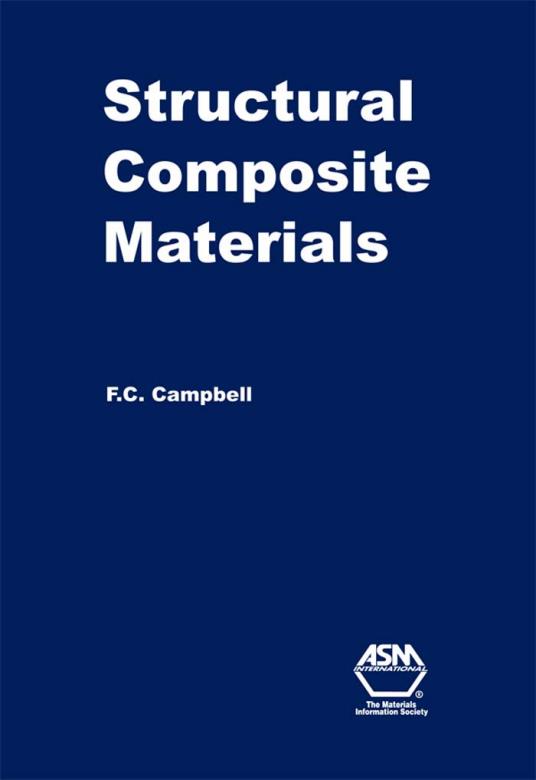
Structural Composite Materials F.C.Campbell The Materials Information Society
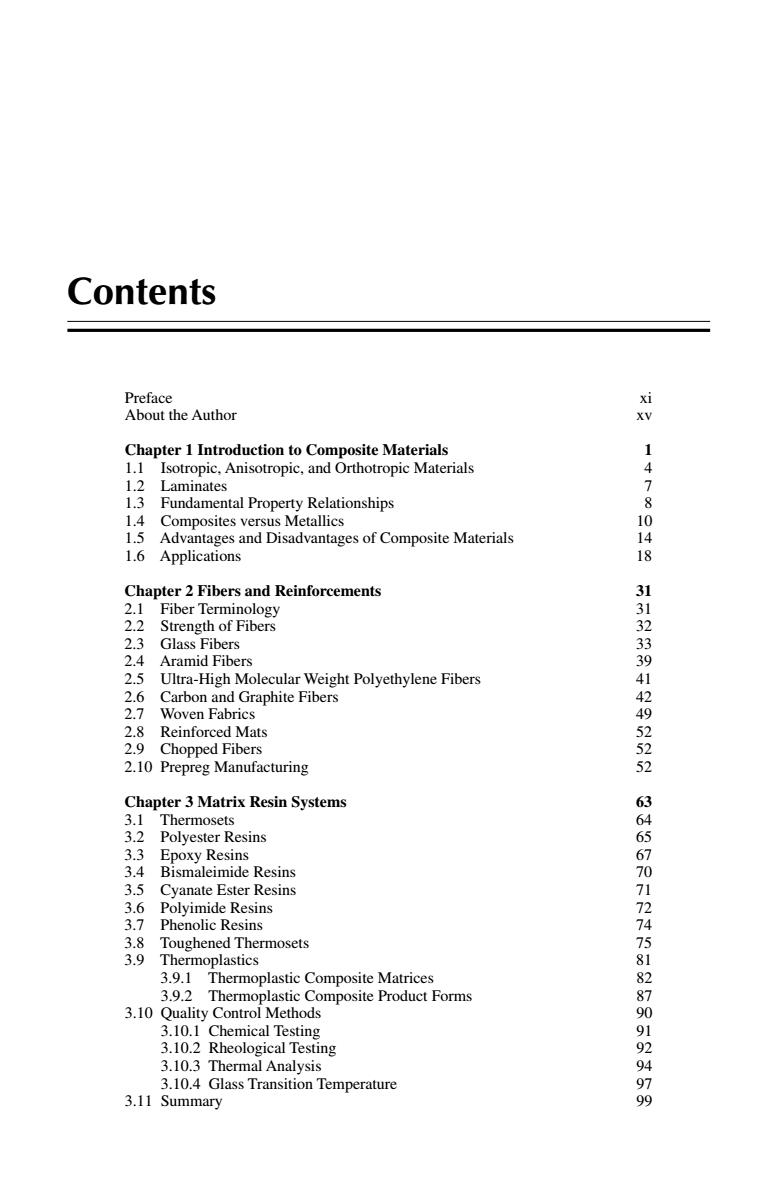
Contents Preface xi About the Author Chapter 1 Introduction to Composite Materials 1.1 Isotropic,Anisotropic,and Orthotropic Materials 1.2 Laminates 47 1.3 Fundamental Property Relationships 1.4 Composites versus Metallics 1 1.5 Advantages and Disadvantages of Composite Materials 4 1.6 Applications Chapter 2 Fibers and Reinforcements 31 2.1 Fiber Terminology 2.2 Strength of Fibers 2.3 Glass Fibers 2.4 Aramid Fibers 12394 2.5 Ultra-High Molecular Weight Polyethylene Fibers 2.6 Carbon and Graphite Fibers 2.7 Woven Fabrics 2.8 Reinforced Mats 2.9 Chopped Fibers 2.10 Prepreg Manufacturing 12192226 Chapter 3 Matrix Resin Systems 3.1 Thermosets 3.2 Polyester Resins 3.3 Epoxy Resins 3.4 Bismaleimide Resins 3.5 Cyanate Ester Resins 3.6 Polyimide Resins 3.7 Phenolic Resins 3.8 Toughened Thermosets 3.9 Thermoplastics 3.9.1 Thermoplastic Composite Matrices 3.9.2 Thermoplastic Composite Product Forms 3.10 Quality Control Methods 3.10.1 Chemical Testing 3.10.2 Rheological Testing 46701245333002499 3.10.3 Thermal Analysis 3.10.4 Glass Transition Temperature 3.11 Summary
Contents Preface xi About the Author xv Chapter 1 Introduction to Composite Materials 1 1.1 Isotropic, Anisotropic, and Orthotropic Materials 4 1.2 Laminates 7 1.3 Fundamental Property Relationships 8 1.4 Composites versus Metallics 10 1.5 Advantages and Disadvantages of Composite Materials 14 1.6 Applications 18 Chapter 2 Fibers and Reinforcements 31 2.1 Fiber Terminology 31 2.2 Strength of Fibers 32 2.3 Glass Fibers 33 2.4 Aramid Fibers 39 2.5 Ultra-High Molecular Weight Polyethylene Fibers 41 2.6 Carbon and Graphite Fibers 42 2.7 Woven Fabrics 49 2.8 Reinforced Mats 52 2.9 Chopped Fibers 52 2.10 Prepreg Manufacturing 52 Chapter 3 Matrix Resin Systems 63 3.1 Thermosets 64 3.2 Polyester Resins 65 3.3 Epoxy Resins 67 3.4 Bismaleimide Resins 70 3.5 Cyanate Ester Resins 71 3.6 Polyimide Resins 72 3.7 Phenolic Resins 74 3.8 Toughened Thermosets 75 3.9 Thermoplastics 81 3.9.1 Thermoplastic Composite Matrices 82 3.9.2 Thermoplastic Composite Product Forms 87 3.10 Quality Control Methods 90 3.10.1 Chemical Testing 91 3.10.2 Rheological Testing 92 3.10.3 Thermal Analysis 94 3.10.4 Glass Transition Temperature 97 3.11 Summary 99
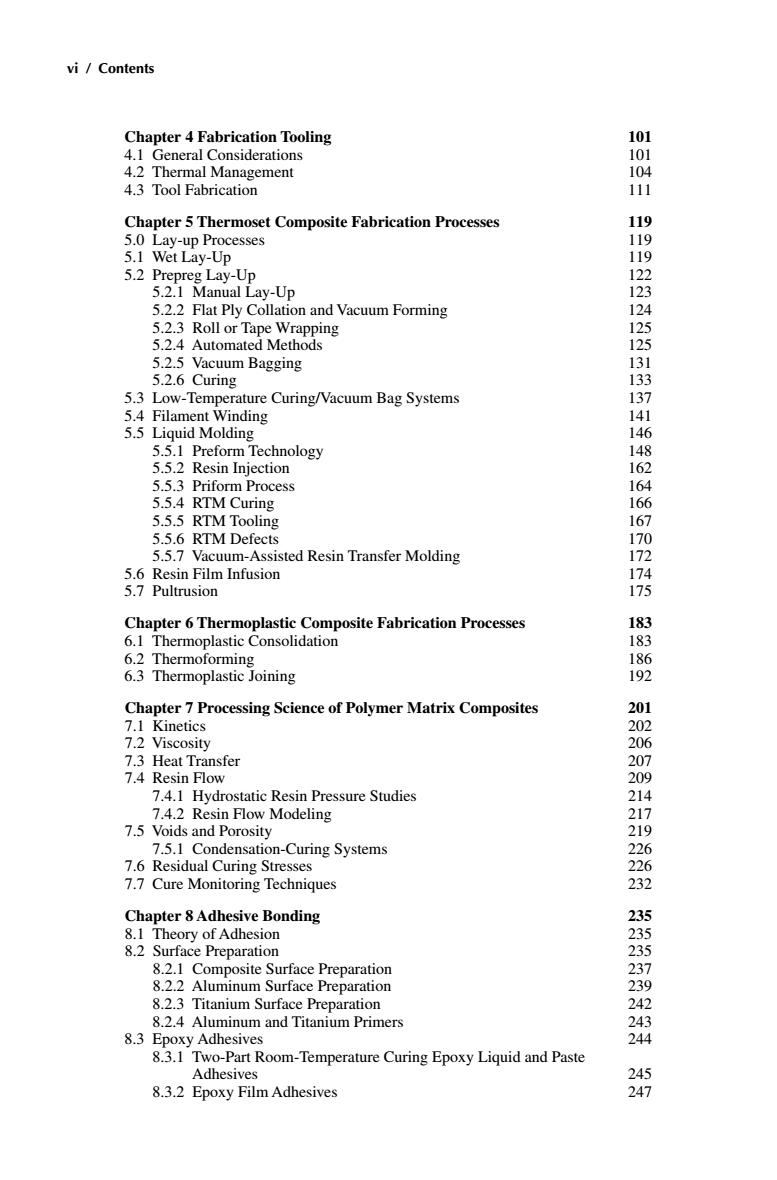
vi Contents Chapter 4 Fabrication Tooling 101 4.1 General Considerations 101 4.2 Thermal Management 104 4.3 Tool Fabrication 111 Chapter 5 Thermoset Composite Fabrication Processes 119 5.0 Lay-up Processes 119 5.1 Wet Lay-Up 119 5.2 Prepreg Lay-Up 5.2.1 Manual Lay-Up 123 5.2.2 Flat Ply Collation and Vacuum Forming 124 5.2.3 Roll or Tape Wrapping 125 5.2.4 Automated Methods 125 5.2.5 Vacuum Bagging 131 5.2.6 Curing 133 5.3 Low-Temperature Curing/Vacuum Bag Systems 137 5.4 Filament Winding 141 5.5 Liquid Molding 146 5.5.1 Preform Technology 148 5.5.2 Resin Injection 162 5.5.3 Priform Process 164 5.5.4 RTM Curing 166 5.5.5 RTM Tooling 167 5.5.6 RTM Defects 170 5.5.7 Vacuum-Assisted Resin Transfer Molding 172 5.6 Resin Film Infusion 174 5.7 Pultrusion 175 Chapter 6 Thermoplastic Composite Fabrication Processes 183 6.1 Thermoplastic Consolidation 183 6.2 Thermoforming 186 6.3 Thermoplastic Joining 192 Chapter 7 Processing Science of Polymer Matrix Composites 201 7.1 Kinetics 202 7.2 Viscosity 206 7.3 Heat Transfer 207 7.4 Resin Flow 209 7.4.1 Hydrostatic Resin Pressure Studies 214 7.4.2 Resin Flow Modeling 217 7.5 Voids and Porosity 219 7.5.1 Condensation-Curing Systems 226 7.6 Residual Curing Stresses 226 7.7 Cure Monitoring Techniques 232 Chapter 8 Adhesive Bonding 235 8.1 Theory of Adhesion 235 8.2 Surface Preparation 235 8.2.1 Composite Surface Preparation 237 8.2.2 Aluminum Surface Preparation 239 8.2.3 Titanium Surface Preparation 242 8.2.4 Aluminum and Titanium Primers 243 8.3 Epoxy Adhesives 244 8.3.1 Two-Part Room-Temperature Curing Epoxy Liquid and Paste Adhesives 245 8.3.2 Epoxy Film Adhesives 247
vi / Contents Chapter 4 Fabrication Tooling 101 4.1 General Considerations 101 4.2 Thermal Management 104 4.3 Tool Fabrication 111 Chapter 5 Thermoset Composite Fabrication Processes 119 5.0 Lay-up Processes 119 5.1 Wet Lay-Up 119 5.2 Prepreg Lay-Up 122 5.2.1 Manual Lay-Up 123 5.2.2 Flat Ply Collation and Vacuum Forming 124 5.2.3 Roll or Tape Wrapping 125 5.2.4 Automated Methods 125 5.2.5 Vacuum Bagging 131 5.2.6 Curing 133 5.3 Low-Temperature Curing/Vacuum Bag Systems 137 5.4 Filament Winding 141 5.5 Liquid Molding 146 5.5.1 Preform Technology 148 5.5.2 Resin Injection 162 5.5.3 Priform Process 164 5.5.4 RTM Curing 166 5.5.5 RTM Tooling 167 5.5.6 RTM Defects 170 5.5.7 Vacuum-Assisted Resin Transfer Molding 172 5.6 Resin Film Infusion 174 5.7 Pultrusion 175 Chapter 6 Thermoplastic Composite Fabrication Processes 183 6.1 Thermoplastic Consolidation 183 6.2 Thermoforming 186 6.3 Thermoplastic Joining 192 Chapter 7 Processing Science of Polymer Matrix Composites 201 7.1 Kinetics 202 7.2 Viscosity 206 7.3 Heat Transfer 207 7.4 Resin Flow 209 7.4.1 Hydrostatic Resin Pressure Studies 214 7.4.2 Resin Flow Modeling 217 7.5 Voids and Porosity 219 7.5.1 Condensation-Curing Systems 226 7.6 Residual Curing Stresses 226 7.7 Cure Monitoring Techniques 232 Chapter 8 Adhesive Bonding 235 8.1 Theory of Adhesion 235 8.2 Surface Preparation 235 8.2.1 Composite Surface Preparation 237 8.2.2 Aluminum Surface Preparation 239 8.2.3 Titanium Surface Preparation 242 8.2.4 Aluminum and Titanium Primers 243 8.3 Epoxy Adhesives 244 8.3.1 Two-Part Room-Temperature Curing Epoxy Liquid and Paste Adhesives 245 8.3.2 Epoxy Film Adhesives 247
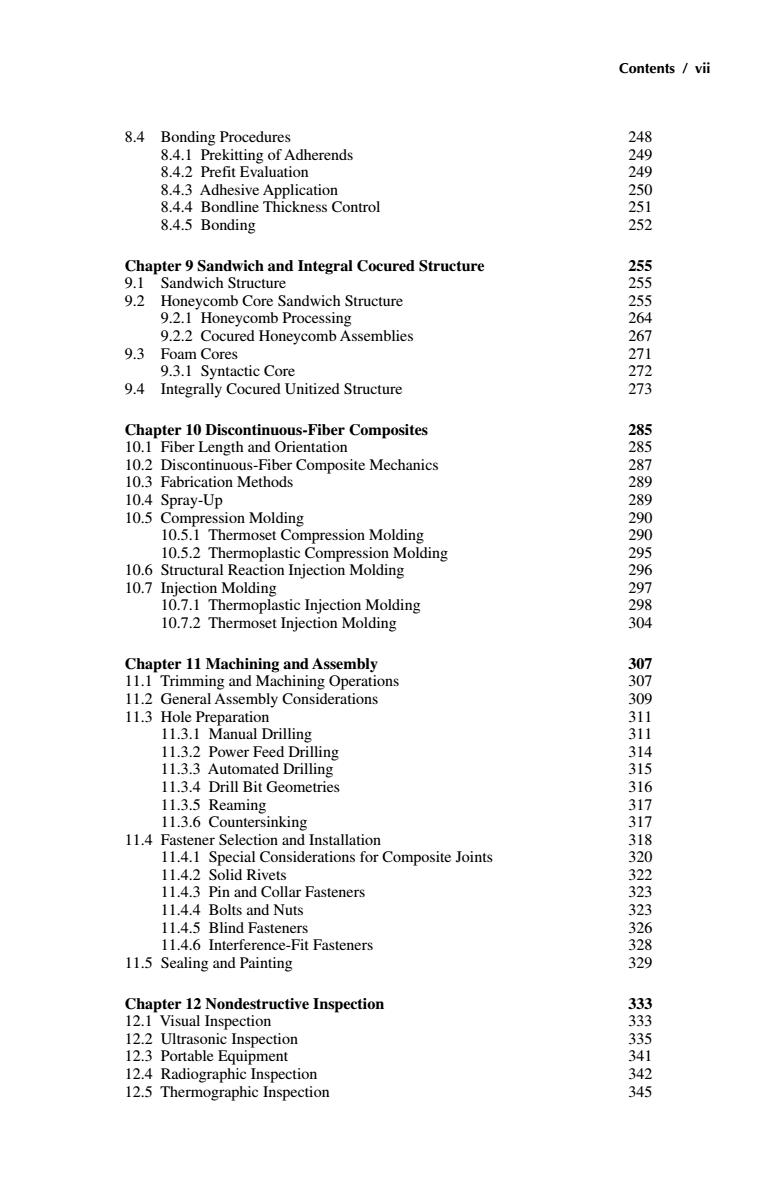
Contents vii 8.4 Bonding Procedures 248 8.4.1 Prekitting of Adherends 249 8.4.2 Prefit Evaluation 249 8.4.3 Adhesive Application 250 8.4.4 Bondline Thickness Control 251 8.4.5 Bonding 252 Chapter 9 Sandwich and Integral Cocured Structure 255 9.1 Sandwich Structure 255 9.2 Honeycomb Core Sandwich Structure 255 9.2.1 Honeycomb Processing 264 9.2.2 Cocured Honeycomb Assemblies 267 9.3 Foam Cores 9.3.1 Syntactic Core 9 9.4 Integrally Cocured Unitized Structure 273 Chapter 10 Discontinuous-Fiber Composites 285 10.1 Fiber Length and Orientation 10.2 Discontinuous-Fiber Composite Mechanics 10.3 Fabrication Methods 289 10.4 Spray-Up 289 10.5 Compression Molding 290 10.5.1 Thermoset Compression Molding 290 10.5.2 Thermoplastic Compression Molding 95 10.6 Structural Reaction Injection Molding 29 10.7 Injection Molding 97 10.7.1 Thermoplastic Injection Molding 298 10.7.2 Thermoset Injection Molding 304 Chapter 11 Machining and Assembly 307 11.1 Trimming and Machining Operations 307 11.2 General Assembly Considerations 309 11.3 Hole Preparation 311 11.3.1 Manual Drilling 311 11.3.2 Power Feed Drilling 314 11.3.3 Automated Drilling 315 11.3.4 Drill Bit Geometries 316 11.3.5 Reaming 317 11.3.6 Countersinking 317 11.4 Fastener Selection and Installation 318 11.4.1 Special Considerations for Composite Joints 320 11.4.2 Solid Rivets 322 11.4.3 Pin and Collar Fasteners 323 11.4.4 Bolts and Nuts 323 11.4.5 Blind Fasteners 326 11.4.6 Interference-Fit Fasteners 328 11.5 Sealing and Painting 329 Chapter 12 Nondestructive Inspection 333 12.1 Visual Inspection 333 12.2 Ultrasonic Inspection 335 12.3 Portable Equipment 341 12.4 Radiographic Inspection 342 12.5 Thermographic Inspection 345
Contents / vii 8.4 Bonding Procedures 248 8.4.1 Prekitting of Adherends 249 8.4.2 Prefit Evaluation 249 8.4.3 Adhesive Application 250 8.4.4 Bondline Thickness Control 251 8.4.5 Bonding 252 Chapter 9 Sandwich and Integral Cocured Structure 255 9.1 Sandwich Structure 255 9.2 Honeycomb Core Sandwich Structure 255 9.2.1 Honeycomb Processing 264 9.2.2 Cocured Honeycomb Assemblies 267 9.3 Foam Cores 271 9.3.1 Syntactic Core 272 9.4 Integrally Cocured Unitized Structure 273 Chapter 10 Discontinuous-Fiber Composites 285 10.1 Fiber Length and Orientation 285 10.2 Discontinuous-Fiber Composite Mechanics 287 10.3 Fabrication Methods 289 10.4 Spray-Up 289 10.5 Compression Molding 290 10.5.1 Thermoset Compression Molding 290 10.5.2 Thermoplastic Compression Molding 295 10.6 Structural Reaction Injection Molding 296 10.7 Injection Molding 297 10.7.1 Thermoplastic Injection Molding 298 10.7.2 Thermoset Injection Molding 304 Chapter 11 Machining and Assembly 307 11.1 Trimming and Machining Operations 307 11.2 General Assembly Considerations 309 11.3 Hole Preparation 311 11.3.1 Manual Drilling 311 11.3.2 Power Feed Drilling 314 11.3.3 Automated Drilling 315 11.3.4 Drill Bit Geometries 316 11.3.5 Reaming 317 11.3.6 Countersinking 317 11.4 Fastener Selection and Installation 318 11.4.1 Special Considerations for Composite Joints 320 11.4.2 Solid Rivets 322 11.4.3 Pin and Collar Fasteners 323 11.4.4 Bolts and Nuts 323 11.4.5 Blind Fasteners 326 11.4.6 Interference-Fit Fasteners 328 11.5 Sealing and Painting 329 Chapter 12 Nondestructive Inspection 333 12.1 Visual Inspection 333 12.2 Ultrasonic Inspection 335 12.3 Portable Equipment 341 12.4 Radiographic Inspection 342 12.5 Thermographic Inspection 345
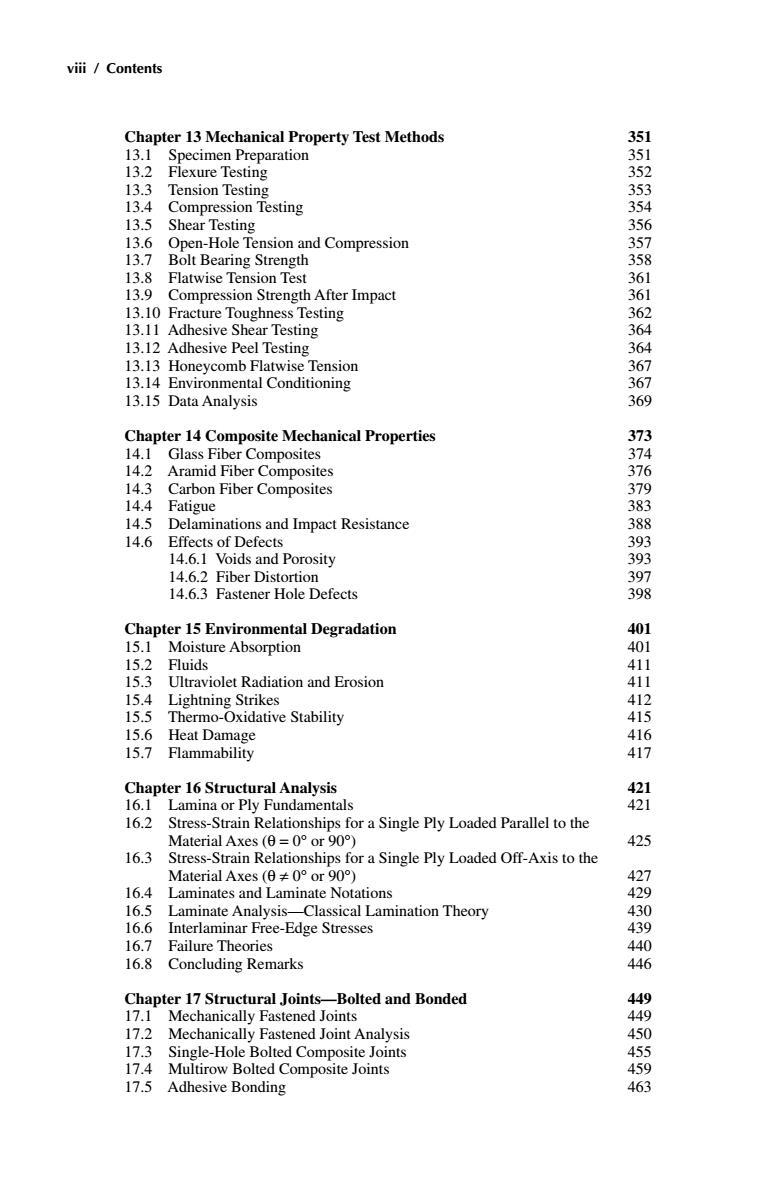
viii /Contents Chapter 13 Mechanical Property Test Methods 13.1 Specimen Preparation 13.2 Flexure Testing 13.3 Tension Testing 13.4 Compression Testing 13.5 Shear Testing 13.6 Open-Hole Tension and Compression 13.7 Bolt Bearing Strength 浙 13.8 Flatwise Tension Test 361 13.9 Compression Strength After Impact 361 13.10 Fracture Toughness Testing 362 13.11 Adhesive Shear Testing 364 13.12 Adhesive Peel Testing 364 13.13 Honeycomb Flatwise Tension 367 13.14 Environmental Conditioning 367 13.15 Data Analysis 369 Chapter 14 Composite Mechanical Properties 373 14.1 Glass Fiber Composites 374 14.2 Aramid Fiber Composites 376 14.3 Carbon Fiber Composites 319 14.4 Fatigue 383 14.5 Delaminations and Impact Resistance 388 14.6 Effects of Defects 393 14.6.1 Voids and Porosity 393 14.6.2 Fiber Distortion 397 14.6.3 Fastener Hole Defects 398 Chapter 15 Environmental Degradation 401 15.1 Moisture Absorption 401 15.2 Fluids 411 15.3 Ultraviolet Radiation and Erosion 411 15.4 Lightning Strikes 412 15.5 Thermo-Oxidative Stability 415 15.6 Heat Damage 416 15.7 Flammability 417 Chapter 16 Structural Analysis 421 16.1 Lamina or Ply Fundamentals 421 16.2 Stress-Strain Relationships for a Single Ply Loaded Parallel to the Material Axes(θ=0°or90) 425 16.3 Stress-Strain Relationships for a Single Ply Loaded Off-Axis to the Material Axes(θ≠0°or90°) 427 16.4 Laminates and Laminate Notations 429 16.5 Laminate Analysis-Classical Lamination Theory 430 16.6 Interlaminar Free-Edge Stresses 439 16.7 Failure Theories 440 16.8 Concluding Remarks 446 Chapter 17 Structural Joints-Bolted and Bonded 449 17.1 Mechanically Fastened Joints 449 17.2 Mechanically Fastened Joint Analysis 450 17.3 Single-Hole Bolted Composite Joints 455 17.4 Multirow Bolted Composite Joints 459 17.5 Adhesive Bonding 463
viii / Contents Chapter 13 Mechanical Property Test Methods 351 13.1 Specimen Preparation 351 13.2 Flexure Testing 352 13.3 Tension Testing 353 13.4 Compression Testing 354 13.5 Shear Testing 356 13.6 Open-Hole Tension and Compression 357 13.7 Bolt Bearing Strength 358 13.8 Flatwise Tension Test 361 13.9 Compression Strength After Impact 361 13.10 Fracture Toughness Testing 362 13.11 Adhesive Shear Testing 364 13.12 Adhesive Peel Testing 364 13.13 Honeycomb Flatwise Tension 367 13.14 Environmental Conditioning 367 13.15 Data Analysis 369 Chapter 14 Composite Mechanical Properties 373 14.1 Glass Fiber Composites 374 14.2 Aramid Fiber Composites 376 14.3 Carbon Fiber Composites 379 14.4 Fatigue 383 14.5 Delaminations and Impact Resistance 388 14.6 Effects of Defects 393 14.6.1 Voids and Porosity 393 14.6.2 Fiber Distortion 397 14.6.3 Fastener Hole Defects 398 Chapter 15 Environmental Degradation 401 15.1 Moisture Absorption 401 15.2 Fluids 411 15.3 Ultraviolet Radiation and Erosion 411 15.4 Lightning Strikes 412 15.5 Thermo-Oxidative Stability 415 15.6 Heat Damage 416 15.7 Flammability 417 Chapter 16 Structural Analysis 421 16.1 Lamina or Ply Fundamentals 421 16.2 Stress-Strain Relationships for a Single Ply Loaded Parallel to the Material Axes (θ = 0° or 90°) 425 16.3 Stress-Strain Relationships for a Single Ply Loaded Off-Axis to the Material Axes (θ ≠ 0° or 90°) 427 16.4 Laminates and Laminate Notations 429 16.5 Laminate Analysis—Classical Lamination Theory 430 16.6 Interlaminar Free-Edge Stresses 439 16.7 Failure Theories 440 16.8 Concluding Remarks 446 Chapter 17 Structural Joints—Bolted and Bonded 449 17.1 Mechanically Fastened Joints 449 17.2 Mechanically Fastened Joint Analysis 450 17.3 Single-Hole Bolted Composite Joints 455 17.4 Multirow Bolted Composite Joints 459 17.5 Adhesive Bonding 463